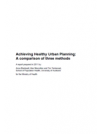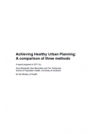This paper compares three of these ways: health impact assessment (HIA); seconding public health professionals to local government (secondment); and community-driven planning, by studying recent New Zealand cases.
The HIA case study showed the potential for HIA to avert significant unforeseen negative health and equity impacts associated with a proposed policy, and to bring an understanding of the social determinants of health to a multidisciplinary setting. HIA was seen as a valuable catalyst for incorporating wellbeing into urban planning.
The secondment case study found that this approach can result in successful and sustained integration of broad health frameworks into the organisational culture of a local government agency. However, in this specific case we looked at, equity considerations had not been fully incorporated into local authority practice.
The community-driven planning case study demonstrated that well-resourced communities can assess local needs and manage projects in partnership with local government. While the financial cost of this process was small, it was very time- and resource-intensive for the community.
The paper provides insights on how best to incorporate health and equity considerations into urban planning, and shows that the three approaches have merit as alternative or complementary methods. The insights offer a useful foundation for both broadening the scope of practice and further evaluating diverse approaches to urban planning.


